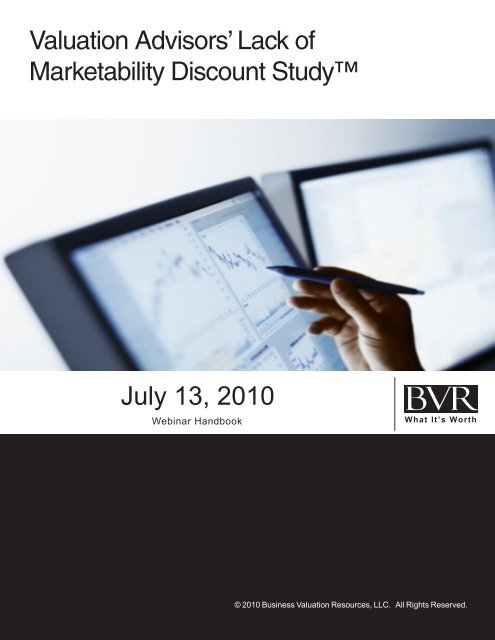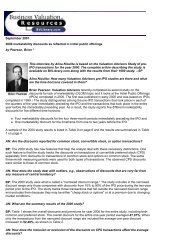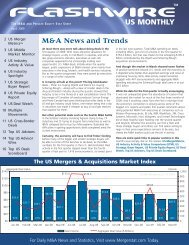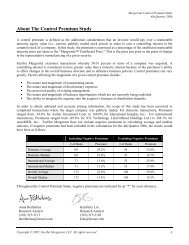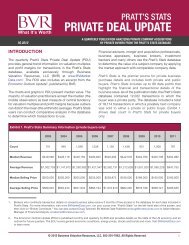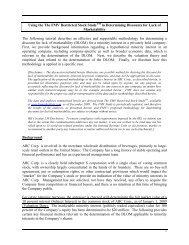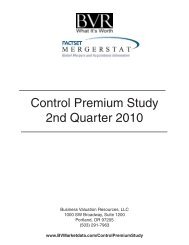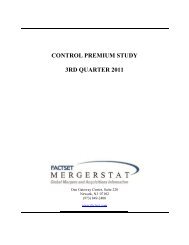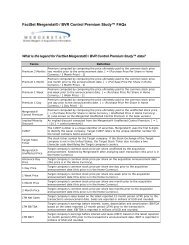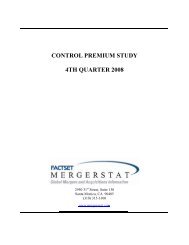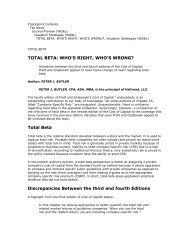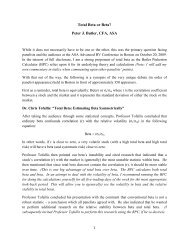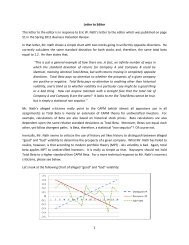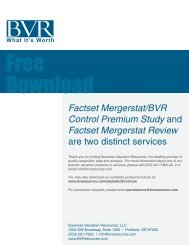Lack of Marketability Discount Study - BVMarketData
Lack of Marketability Discount Study - BVMarketData
Lack of Marketability Discount Study - BVMarketData
- No tags were found...
You also want an ePaper? Increase the reach of your titles
YUMPU automatically turns print PDFs into web optimized ePapers that Google loves.
Valuation Advisors’ <strong>Lack</strong> <strong>of</strong><strong>Marketability</strong> <strong>Discount</strong> <strong>Study</strong>A Free BVR WebinarWebinar HandbookJuly 13, 2010Presenter:Brian K. Pearson, CPA/PFS/ABV, ASAPlease note: This Handbook does not qualify for self study CPE credits.Copyright © 2010 Business Valuation Resources, LLC (BVR). All rights reserved. The materialscontained herein represent the opinions <strong>of</strong> each contributing author, not those <strong>of</strong> BVR. Please notethis handbook can not be reproduced or distributed without written consent. Please contact BVR atpermissions@bvresources.com or call 503-291-7963 to inquire about permission to reprint or purchase asite license for multiple users.
Table <strong>of</strong> ContentsPresenter Biography 7Presentation Materials 11Transcript 35
Valuation Advisors’ <strong>Lack</strong> <strong>of</strong> <strong>Marketability</strong> <strong>Study</strong> - A Free BVR WebinarWebinar Presenter BiographyBrian K. Pearson, CPA/PFS/ABV, ASAMr. Pearson is the founder and President <strong>of</strong> Valuation Advisors,LLC. Valuation Advisors specializes in the determination <strong>of</strong> valuefor private and public companies on for a wide range <strong>of</strong> valuationservices.Mr. Pearson has over 21 years experience in providing businessvaluation consulting. He also has over 10 years <strong>of</strong> “big four”public accounting experience with an emphasis on advisingclosely held business owners on various tax and financial matters,including business valuations. He has obtained his AccreditedBusiness Valuation (ABV) and Personal Financial Specialist(PFS) designations from the American Institute <strong>of</strong> CertifiedPublic Accountants (AICPA), and also has his Accredited SeniorAppraiser (ASA) designation from the American Society <strong>of</strong> Appraisers.Mr. Pearson has a Bachelors <strong>of</strong> Science degree in Accounting and a Masters degree inBusiness Administration, with a specialization in Finance. He is a member <strong>of</strong> the AIPCA, theWestern New York Venture Group, the Estate Analysts <strong>of</strong> Western New York, the AmericanSociety <strong>of</strong> Appraisers, and the New York State Society <strong>of</strong> Certified Public Accountants(NYSSCPA). He has also taught valuation courses for the AICPA, NYSSCPA, the Graduate TaxCertificate program, Center for Entrepreneurial Leadership at the State University <strong>of</strong> New Yorkat Buffalo, and the Annual Tax Institute. He is the Chairman <strong>of</strong> the New York State Society <strong>of</strong>CPA’s Business Valuation committee and a member <strong>of</strong> their finance and investment committees.He is also a member <strong>of</strong> the AICPA ABV exam writing committee.Mr. Pearson is the also creator <strong>of</strong> the Valuation Advisors’ <strong>Lack</strong> <strong>of</strong> <strong>Marketability</strong> <strong>Discount</strong> <strong>Study</strong>database currently available thru Business Valuation Resources© 2010 Business Valuation Resources, LLC. All Rights Reserved.7
Valuation Advisors’ <strong>Lack</strong> <strong>of</strong><strong>Marketability</strong> <strong>Discount</strong> <strong>Study</strong>A Free BVR WebinarWebinar HandbookJuly 13, 2010Presenter:Brian K. Pearson, CPA/PFS/ABV, ASAPlease note: This Handbook does not qualify for self study CPE credits.Copyright © 2010 Business Valuation Resources, LLC (BVR). All rights reserved. The materialscontained herein represent the opinions <strong>of</strong> each contributing author, not those <strong>of</strong> BVR. Please notethis handbook can not be reproduced or distributed without written consent. Please contact BVR atpermissions@bvresources.com or call 503-291-7963 to inquire about permission to reprint or purchase asite license for multiple users.
Valuation Advisors’ <strong>Lack</strong> <strong>of</strong> <strong>Marketability</strong> <strong>Study</strong> - A Free BVR WebinarValuation Advisors DLOM <strong>Study</strong>Brian K. Pearson, CPA/ABV/CFF/PFS, ASAValuation Advisors, LLCwww.valuationpros.comI. The IPO Market – Now versus ThenA. Difficulties in Going PublicB. Impact <strong>of</strong> PricingC. Sarbanes-Oxley related issuesD. Market volatility on pricingE. Equity versus Debt in capital structureF. Impact <strong>of</strong> Merger & Acquisition MarketII. Examples from Valuation Advisors <strong>Discount</strong> for <strong>Lack</strong> <strong>of</strong><strong>Marketability</strong> DatabaseIII. New 1999 Convertible Preferred Stock TransactionsIV.Some Recent General <strong>Lack</strong> <strong>of</strong> <strong>Marketability</strong> ExamplesA. Greek BondsB. European BanksC. Private Equity Limited Partnership InterestsD. Blockbuster, Fannie Mae/Freddie Mac© 2010 Business Valuation Resources, LLC Questions@BVResources.com© 2010 Business Valuation Resources, LLC© 2010 Business Valuation Resources, LLC. All Rights Reserved.11
Valuation Advisors’ <strong>Lack</strong> <strong>of</strong> <strong>Marketability</strong> <strong>Study</strong> - A Free BVR WebinarValuation Advisors DLOM <strong>Study</strong>A. Difficulties in Going Public1. Year to date – 64 Initial Public OfferingsCompared to 63 in all <strong>of</strong> 20092. Larger <strong>of</strong>ferings in 2008:Only 2 2010 IPOs raised over $500 million,compared to 10 in 2009• Dollar General• Banco Santander• Verisk Analytics• Shanda Games• Hyatt Hotels• Starwood Properties© 2010 Business Valuation Resources, LLC Questions@BVResources.com3. Upside• 2010 – 135 year to date IPO filings versus 120 all <strong>of</strong>last year• 19 withdrawn IPO filings year to date versus 49 in2009, but 34 through 6/30/09© 2010 Business Valuation Resources, LLC Questions@BVResources.com12© 2010 Business Valuation Resources, LLC© 2010 Business Valuation Resources, LLC. All Rights Reserved.
Valuation Advisors’ <strong>Lack</strong> <strong>of</strong> <strong>Marketability</strong> <strong>Study</strong> - A Free BVR WebinarValuation Advisors DLOM <strong>Study</strong>B. Pricing• IPO Market Impact on:• Mergers & Acquisitions• Acquisition Multiples• Capital Raising© 2010 Business Valuation Resources, LLC Questions@BVResources.comC. SARBOX• Initial and Annual Costs• Impact on small companies anddevelopment stage companies• Lower investor returns• Larger capital raises needed© 2010 Business Valuation Resources, LLC Questions@BVResources.com© 2010 Business Valuation Resources, LLC© 2010 Business Valuation Resources, LLC. All Rights Reserved.13
Valuation Advisors’ <strong>Lack</strong> <strong>of</strong> <strong>Marketability</strong> <strong>Study</strong> - A Free BVR WebinarValuation Advisors DLOM <strong>Study</strong>D. Market Volatility Impact on Pricing◦ Does volatility equal risk?◦ Impact on IPO Market◦ Flash Crash, VIX, etc.E. Equity versus Debt in Capital Structureo As risk rises, so does RROEo Lower cash flow based lending multipleo Tighter bank lending – fewer dealso Slower growth – longer cycle to IPO or sale© 2010 Business Valuation Resources, LLC Questions@BVResources.comF. Impact <strong>of</strong> M&A Marketo Less deals – less IPOsooMore deals – more IPOsReflects fluidity <strong>of</strong> capital© 2010 Business Valuation Resources, LLC Questions@BVResources.com14© 2010 Business Valuation Resources, LLC© 2010 Business Valuation Resources, LLC. All Rights Reserved.
Valuation Advisors’ <strong>Lack</strong> <strong>of</strong> <strong>Marketability</strong> <strong>Study</strong> - A Free BVR WebinarValuation Advisors DLOM <strong>Study</strong>Examples from theValuation Advisors<strong>Discount</strong> for <strong>Lack</strong> <strong>of</strong><strong>Marketability</strong> Database© 2010 Business Valuation Resources, LLC Questions@BVResources.com© 2010 Business Valuation Resources, LLC Questions@BVResources.com© 2010 Business Valuation Resources, LLC© 2010 Business Valuation Resources, LLC. All Rights Reserved.15
Valuation Advisors’ <strong>Lack</strong> <strong>of</strong> <strong>Marketability</strong> <strong>Study</strong> - A Free BVR WebinarValuation Advisors DLOM <strong>Study</strong>© 2010 Business Valuation Resources, LLC Questions@BVResources.comStock Only Search© 2010 Business Valuation Resources, LLC Questions@BVResources.com16© 2010 Business Valuation Resources, LLC© 2010 Business Valuation Resources, LLC. All Rights Reserved.
Valuation Advisors’ <strong>Lack</strong> <strong>of</strong> <strong>Marketability</strong> <strong>Study</strong> - A Free BVR WebinarValuation Advisors DLOM <strong>Study</strong>© 2010 Business Valuation Resources, LLC Questions@BVResources.com© 2010 Business Valuation Resources, LLC Questions@BVResources.com© 2010 Business Valuation Resources, LLC© 2010 Business Valuation Resources, LLC. All Rights Reserved.17
Valuation Advisors’ <strong>Lack</strong> <strong>of</strong> <strong>Marketability</strong> <strong>Study</strong> - A Free BVR WebinarValuation Advisors DLOM <strong>Study</strong>© 2010 Business Valuation Resources, LLC Questions@BVResources.comMedical DeviceCompanies© 2010 Business Valuation Resources, LLC Questions@BVResources.com18© 2010 Business Valuation Resources, LLC© 2010 Business Valuation Resources, LLC. All Rights Reserved.
Valuation Advisors’ <strong>Lack</strong> <strong>of</strong> <strong>Marketability</strong> <strong>Study</strong> - A Free BVR WebinarValuation Advisors DLOM <strong>Study</strong>© 2010 Business Valuation Resources, LLC Questions@BVResources.com© 2010 Business Valuation Resources, LLC Questions@BVResources.com© 2010 Business Valuation Resources, LLC© 2010 Business Valuation Resources, LLC. All Rights Reserved.19
Valuation Advisors’ <strong>Lack</strong> <strong>of</strong> <strong>Marketability</strong> <strong>Study</strong> - A Free BVR WebinarValuation Advisors DLOM <strong>Study</strong>You have been asked todetermine the DLOMfor a stock option inthe medical field.© 2010 Business Valuation Resources, LLC Questions@BVResources.com© 2010 Business Valuation Resources, LLC Questions@BVResources.com20© 2010 Business Valuation Resources, LLC© 2010 Business Valuation Resources, LLC. All Rights Reserved.
Valuation Advisors’ <strong>Lack</strong> <strong>of</strong> <strong>Marketability</strong> <strong>Study</strong> - A Free BVR WebinarValuation Advisors DLOM <strong>Study</strong>© 2010 Business Valuation Resources, LLC Questions@BVResources.com© 2010 Business Valuation Resources, LLC Questions@BVResources.com© 2010 Business Valuation Resources, LLC© 2010 Business Valuation Resources, LLC. All Rights Reserved.21
Valuation Advisors’ <strong>Lack</strong> <strong>of</strong> <strong>Marketability</strong> <strong>Study</strong> - A Free BVR WebinarValuation Advisors DLOM <strong>Study</strong>S<strong>of</strong>tware Transactions© 2010 Business Valuation Resources, LLC Questions@BVResources.com© 2010 Business Valuation Resources, LLC Questions@BVResources.com22© 2010 Business Valuation Resources, LLC© 2010 Business Valuation Resources, LLC. All Rights Reserved.
Valuation Advisors’ <strong>Lack</strong> <strong>of</strong> <strong>Marketability</strong> <strong>Study</strong> - A Free BVR WebinarValuation Advisors DLOM <strong>Study</strong>© 2010 Business Valuation Resources, LLC Questions@BVResources.comStock and CPStransactions can beconsidered separately© 2010 Business Valuation Resources, LLC Questions@BVResources.com© 2010 Business Valuation Resources, LLC© 2010 Business Valuation Resources, LLC. All Rights Reserved.23
Valuation Advisors’ <strong>Lack</strong> <strong>of</strong> <strong>Marketability</strong> <strong>Study</strong> - A Free BVR WebinarValuation Advisors DLOM <strong>Study</strong>© 2010 Business Valuation Resources, LLC Questions@BVResources.com© 2010 Business Valuation Resources, LLC Questions@BVResources.com24© 2010 Business Valuation Resources, LLC© 2010 Business Valuation Resources, LLC. All Rights Reserved.
Valuation Advisors’ <strong>Lack</strong> <strong>of</strong> <strong>Marketability</strong> <strong>Study</strong> - A Free BVR WebinarValuation Advisors DLOM <strong>Study</strong>© 2010 Business Valuation Resources, LLC Questions@BVResources.com© 2010 Business Valuation Resources, LLC Questions@BVResources.com© 2010 Business Valuation Resources, LLC© 2010 Business Valuation Resources, LLC. All Rights Reserved.25
Valuation Advisors’ <strong>Lack</strong> <strong>of</strong> <strong>Marketability</strong> <strong>Study</strong> - A Free BVR WebinarValuation Advisors DLOM <strong>Study</strong>© 2010 Business Valuation Resources, LLC Questions@BVResources.comWe revisited the year1999 IPO Filings© 2010 Business Valuation Resources, LLC Questions@BVResources.com26© 2010 Business Valuation Resources, LLC© 2010 Business Valuation Resources, LLC. All Rights Reserved.
Valuation Advisors’ <strong>Lack</strong> <strong>of</strong> <strong>Marketability</strong> <strong>Study</strong> - A Free BVR WebinarValuation Advisors DLOM <strong>Study</strong> Newly added CPS transactions from 1999CPS Only Transactions1999Timeframe Mean Median Count0‐3 Months 40.30% 42.10% 544‐6 Months 59.20% 62.60% 747‐9 Months 61.10% 68.60% 4410‐12 Months 73.20% 77.00% 561‐2 Years 75.50% 80.10% 142Total 65.30% 69.20% 370© 2010 Business Valuation Resources, LLC Questions@BVResources.com© 2010 Business Valuation Resources, LLC Questions@BVResources.com© 2010 Business Valuation Resources, LLC© 2010 Business Valuation Resources, LLC. All Rights Reserved.27
Valuation Advisors’ <strong>Lack</strong> <strong>of</strong> <strong>Marketability</strong> <strong>Study</strong> - A Free BVR WebinarValuation Advisors DLOM <strong>Study</strong> Comparison to more recent CPS Data:CPS Only Transactions1999 2007 ‐ 2010Timeframe Mean Median Count Mean Median Count4‐6 Months 59.20% 62.60% 74 23.40% 27.30% 147‐9 Months 61.10% 68.60% 44 25.50% 39.10% 1310‐12 Months 73.20% 77.00% 56 43.10% 44.80% 101‐2 Years 75.50% 80.10% 142 40.90% 48.70% 33Total 65.30% 69.20% 316 33.80% 38.60% 70© 2010 Business Valuation Resources, LLC Questions@BVResources.com© 2010 Business Valuation Resources, LLC Questions@BVResources.com28© 2010 Business Valuation Resources, LLC© 2010 Business Valuation Resources, LLC. All Rights Reserved.
Valuation Advisors’ <strong>Lack</strong> <strong>of</strong> <strong>Marketability</strong> <strong>Study</strong> - A Free BVR WebinarValuation Advisors DLOM <strong>Study</strong>Recent delistingexamples:© 2010 Business Valuation Resources, LLC Questions@BVResources.com© 2010 Business Valuation Resources, LLC Questions@BVResources.com© 2010 Business Valuation Resources, LLC© 2010 Business Valuation Resources, LLC. All Rights Reserved.29
Valuation Advisors’ <strong>Lack</strong> <strong>of</strong> <strong>Marketability</strong> <strong>Study</strong> - A Free BVR WebinarValuation Advisors DLOM <strong>Study</strong>© 2010 Business Valuation Resources, LLC Questions@BVResources.com© 2010 Business Valuation Resources, LLC Questions@BVResources.com30© 2010 Business Valuation Resources, LLC© 2010 Business Valuation Resources, LLC. All Rights Reserved.
Valuation Advisors’ <strong>Lack</strong> <strong>of</strong><strong>Marketability</strong> <strong>Discount</strong> <strong>Study</strong>A Free BVR WebinarWebinar HandbookJuly 13, 2010Presenter:Brian K. Pearson, CPA/PFS/ABV, ASAPlease note: This Handbook does not qualify for self study CPE credits.Copyright © 2010 Business Valuation Resources, LLC (BVR). All rights reserved. The materialscontained herein represent the opinions <strong>of</strong> each contributing author, not those <strong>of</strong> BVR. Please notethis handbook can not be reproduced or distributed without written consent. Please contact BVR atpermissions@bvresources.com or call 503-291-7963 to inquire about permission to reprint or purchase asite license for multiple users.
Valuation Advisors’ <strong>Lack</strong> <strong>of</strong> <strong>Marketability</strong> <strong>Study</strong> - A Free BVR WebinarValuation Advisors DLOM <strong>Study</strong>Business Valuation ResourcesJuly 13, 2010/10:00 a.m. PTBlake Lyman:Hello and welcome to Valuation Advisors DLOM <strong>Study</strong>, a freeBVR webinar featuring Brian Pearson. My name is Blake Lyman,Pr<strong>of</strong>essional Program Manager at BVR.Today, BVR welcomes Brian Pearson, developer and guru <strong>of</strong> theValuation Advisors’ <strong>Lack</strong> <strong>of</strong> <strong>Marketability</strong> <strong>Discount</strong> <strong>Study</strong>. Overthe next hour, Brian will provide a complete look at this powerfulvaluation tool which compares the initial public <strong>of</strong>fering stock priceto pre-IPO common stock, common stock option and convertiblepreferred stock prices.In the interest <strong>of</strong> time, I’ll forgo Brian’s impressive bio and direct youto the webpage for today’s webinar where you can read all aboutour illustrious presenter.As a final note, if you plan to use any <strong>of</strong> the materials in thispresentation today, please attribute them to both Valuation Advisorsand Business Valuation Resources.With that, I’ll welcome Brian Pearson. Brian?Brian Pearson:Blake, thank you for that very generous introduction. Goodafternoon, everybody.What I want to do today is give you an overview <strong>of</strong> the currentstate <strong>of</strong> the IPO market, and with that, transition into an updatethat we’ve performed on our database going back many years andacquiring many more convertible preferred transactions showingyou what those discounts look like, as well as just giving you anoverview <strong>of</strong> some recent examples <strong>of</strong> lack <strong>of</strong> marketability. SoI think it will just be a currently topical discussion <strong>of</strong> not only thedatabase but some other things out there that are impacting thedatabase.One <strong>of</strong> the things I think that has created some difficulty over thelast three or four years is just that the IPO market itself has sloweddown quite a bit, and obviously, that’s really been a function <strong>of</strong> thecapital markets.This year, the IPO markets have picked up somewhat compared tolast year. At this point, this year, we have 64 initial public <strong>of</strong>ferings© 2010 Business Valuation Resources, LLC. All Rights Reserved.35
Valuation Advisors’ <strong>Lack</strong> <strong>of</strong> <strong>Marketability</strong> <strong>Study</strong> - A Free BVR Webinarcompared to 63 all <strong>of</strong> last year. The primary difference betweenthe two years is even though last year was a lighter year as far asIPOs, the number <strong>of</strong> capital raised in those IPOs was larger.With an equal number <strong>of</strong> IPOs for the full year last year versus thehalf year this year, last year, there was about twice as much capitalraised and that was really a function <strong>of</strong> some large IPOs, and thoseare listed on the slide that you can see on your screen. Those arejust a couple <strong>of</strong> the companies that had gone public last year, andobviously, we haven’t had similar slides <strong>of</strong> companies this year.We’ve only had two IPOs this year with over $500 million <strong>of</strong> capitalraised versus ten last year.Now obviously as the markets continue to improve, the likelihood<strong>of</strong> that happening will increase and I think you’ve probably heardsomething in the press that there’s a small company out therecalled General Motors that might go public later this year. So thatwill clearly pick up the overall size <strong>of</strong> capital raised via IPOs for theyear.What is interesting is that the upside to the fact that the IPO marketis starting to pick up is reflected in that this year we had 135 filingsyear-to-date versus 120 all <strong>of</strong> last year, and we’ve only had 19 IPOswithdrawn this year versus 49 last year.Really what that’s telling you is that the IPO market itself is queuedup to have a fair bit greater activity as long as the general economicfactors in the economy and market conditions remain stable.That really leads into my next slide which is just the pricing <strong>of</strong> IPOsin the market itself.The IPO market is very contingent upon capital conditions andlinked very closely to the merger and acquisition market. It’shard to say which one leads the other but they’re pretty intricatelyinvolved.Essentially without an active IPO market, what you end up withis a situation where private companies really have only one exitstrategy.You can think about it as kind <strong>of</strong> a fork in the road, if you will. Whenyou have two paths you can go down, obviously, it creates a little bitmore buyer activity.36© 2010 Business Valuation Resources, LLC. All Rights Reserved.
Valuation Advisors’ <strong>Lack</strong> <strong>of</strong> <strong>Marketability</strong> <strong>Study</strong> - A Free BVR WebinarWhen the IPO path is closed or severely limited, which it’s beenprobably the past several years, it really takes all the traffic down toone path which is a sale to another company, and what that createsis it creates an opportunity for buyers to demand lower multiplesfrom sellers.What you have is you have a situation where the multiples that arebeing paid in acquisitions tend to fall, and obviously, when thosemultiples fall, that impacts the perception <strong>of</strong> everyone becausetypically, public multiples follow private multiples and vice versa.What you have is capital markets then starting to contract and it canbe <strong>of</strong>tentimes a spiraling effect as we witnessed probably 12 to 18months ago with the public market and that’s had a severe impacton the IPO market. There were months where there was just noactivity.It also has a pretty severe impact on capital raising. So as youhave acquisition multiples fall, raising capital becomes moreexpensive just because there’s the perceived risk amongst lenders,especially the risk <strong>of</strong> their getting their capital back goes up quitea bit, and the only way to accommodate that, <strong>of</strong> course, is to eitherlend less <strong>of</strong> it or charge more for such capital.In either way you do that, you end up typically with a lower return toan equity investor using the form <strong>of</strong> greater dissolution via the factthat they have to put more equity into a deal or simply the fact that ifyou have to pay more for the debt side <strong>of</strong> the equation, there’s less<strong>of</strong> a return for the equity side <strong>of</strong> the equation.Probably one <strong>of</strong> the more recent reflections <strong>of</strong> that was back inthe spring when our former Federal Reserve Chairman, AlanGreenspan, gave an interview in the Financial Times titled, WeNeed a Better Cushion Against Risk. He said, “I believe that recentrisk spreads suggest that markets require perhaps 13 or 14 percentcapital (up from 10 percent) before U.S. banks are likely to lendfreely again.”I think what he was essentially saying there was that the requiredrate <strong>of</strong> return on equity has gone up, in his example, 30 percentto 40 percent. When you have that happen, there’s obviously theperception that you have to have higher equity in deals to get dealsout and that slows down an IPO market as well and makes it muchmore dilutive.© 2010 Business Valuation Resources, LLC. All Rights Reserved.37
Valuation Advisors’ <strong>Lack</strong> <strong>of</strong> <strong>Marketability</strong> <strong>Study</strong> - A Free BVR WebinarThe next slide that I’m going to talk about is one <strong>of</strong> the big factorsthat’s impacted smaller IPOs. Going back ten years ago, it wasmuch easier for small companies to go public via the IPO route andthat was companies that either were small but had potential andwere growing quickly or even companies that were developmentstagecompanies that might have had interesting technology and Iguess you can think <strong>of</strong> drug development companies especially.One <strong>of</strong> the key issues that’s happened since then has beenSarbanes-Oxley and Sarbanes-Oxley has really raised the costsignificantly to be a publicly-traded company. There’s been anumber <strong>of</strong> estimates out there but the estimates typically rangefrom, on the low end, $25 million, to the high end, maybe $3 million.You can think <strong>of</strong> small companies that just don’t have the ability toraise that kind <strong>of</strong> capital, and if they do raise that kind <strong>of</strong> capital, thepercentage that eats up just in what would be preparing to go publicand then the potential public costs after that.The end result <strong>of</strong> that, <strong>of</strong> course, is, once again, you have lowerinvestor returns and you have larger capital raises needed andthe result is the same as I talked about earlier, which is that eitherway, you end up with dilution and overall lower returns to an equityinvestor.The fourth area that I wanted to talk about that impacts IPOs wouldbe market volatility. Recently, we’ve had a few swings upward anddownward in the stock market and that volatility has a fairly largeimpact on the way investors perceive risk.I have a question on the slide labeled, “Does volatility equal risk?”and I guess that’s the $64,000 question and we could probably behere all day just debating that. But the fact is that volatility doesincrease perceived risk whether it increases actual risk or not, andperceived risk is <strong>of</strong>tentimes what impacts the ability to raise capital.The perception that the risk has gone up makes it more difficult toraise capital.The impact on the IPO market typically is when there is anincrease in actual risk or perceived risk, it makes it more difficult forcompanies to sell shares to the public.You can think <strong>of</strong> some recent examples <strong>of</strong> like the Flash Crashwhere you had one day where the market fell significantly intradayand rebounded but still closed down quite a bit. Then you had a38© 2010 Business Valuation Resources, LLC. All Rights Reserved.
Valuation Advisors’ <strong>Lack</strong> <strong>of</strong> <strong>Marketability</strong> <strong>Study</strong> - A Free BVR Webinarsubsequent fall in the market and rebound. Those kinds <strong>of</strong> factors<strong>of</strong> volatility over short periods <strong>of</strong> time can impact the IPO marketpretty significantly.You can have companies that may be fine companies and would beable to go public under other circumstances. Yet, if their timing issuch that they’re scheduled to go public in a week where you havesomething like that happen, <strong>of</strong>tentimes they can’t sell their shares inthat week and their window closes, if you will – it’s not an unlimitedwindow. Once that window closes, the ability for them to go publictypically closes maybe for another 12 to 24 months and possiblyforever depending upon their ability to sustain operations if theyaren’t cash flow positive.What you have essentially is investors and potential IPOs generallyare more willing to part with their money when they view stockprices with an upward trajectory.If you have a situation where potential investors view the marketas having more <strong>of</strong> a downward trajectory, they’re less likely to partwith their money and, therefore, less likely to buy shares in a public<strong>of</strong>fering.There are a couple <strong>of</strong> situations where that’s happened recentlyand these are actual quotes from companies that were going to gopublic or from their press releases.There was a company back on May 6 th that was a Hong Kongbased company that was going to sell shares in the U.S. It wasSwire Properties which is a conglomerate, part <strong>of</strong> Swire PacificLimited. The issued press release basically said, “There isn’tsufficient demand from both institutional and retail investors at theprice it expects,” meaning they had scheduled/filed to go public ata particular price and they didn’t have sufficient investors at thatprice.“Demand for the developer’s IPO has been hit by more than 5percent fall in the local benchmark Hang Seng index since thecompany began bookbuilding April 26.” Bookbuilding is acquiringthe investors in the IPO. A company goes out and they market theirshares typically via a road show, or the investment banker does,and they’re basically building their books so that they can commit tosaying, “Yeah, we’re going to sell 5 million shares at $10 a share,”and they have those commitments.© 2010 Business Valuation Resources, LLC. All Rights Reserved.39
Valuation Advisors’ <strong>Lack</strong> <strong>of</strong> <strong>Marketability</strong> <strong>Study</strong> - A Free BVR WebinarWhen you get a lot <strong>of</strong> market volatility, people who have committedand back <strong>of</strong>f the commitments <strong>of</strong>tentimes are people that arethinking about committing and just saying, “It’s not the rightenvironment for me.” So essentially, the company can’t sell theirshares at that point.What’s interesting about that particular company that was goingpublic was that the IPO price, since it was a real estate orientedcompany, was already at a discount to net asset value and they stillcouldn’t take the company public. So it’s a pretty good indicator <strong>of</strong>how difficult it can be to take a company public when you have asituation where in that scenario where the Hang Seng index wasthe index that fell. I gave you that because that was just a pressrelease that was out there but there’s been a number <strong>of</strong> similarpress releases this year with U.S. based companies where that’shappened as well.The last area that I wanted to cover kind <strong>of</strong> on the update <strong>of</strong> theIPO market just as in general is equity versus debt in capitalstructure. I alluded to this earlier that essentially, as the difficulty inacquiring debt based capital from lenders has risen, the need forhigher level <strong>of</strong> equity in the capital structure has risen. Essentially,what that means is that your required rate <strong>of</strong> return equity also risesand all <strong>of</strong> that leads to a situation where it becomes harder to raisethe necessary capital to get companies to go public. Essentially, itleads to a longer cycle to an IPO or a potential sale because what’sleft, capital for growth or deal making, it’s a slower path for the pre-IPO company and it becomes less attractive.You can see kind <strong>of</strong> the impact that market volatility has on a lot <strong>of</strong>areas but certainly on the initial public <strong>of</strong>fering market and that’sdirectly related to both the capital market and to the merger andacquisition market.My next slide simply lays out that when you have less deals in theM&A environment, you also have less IPOs, and when you havemore deals in the M&A market, you have more IPOs. In my mind,it just reflects the fluidity <strong>of</strong> capital, if you will, that when capital isflowing, it’s much easier to take a company public than it is when itisn’t flowing.Right now we’re at that point where the spigots have been turnedback on a little bit but clearly not like they’ve been over the last 15years, and certainly a long way from 1999 which is what I’m goingto show you in a little bit.40© 2010 Business Valuation Resources, LLC. All Rights Reserved.
Valuation Advisors’ <strong>Lack</strong> <strong>of</strong> <strong>Marketability</strong> <strong>Study</strong> - A Free BVR WebinarWith that, I’ll give you some examples, I think, <strong>of</strong> what our databaselooks like.That’s a big picture overview <strong>of</strong> the current IPO market.Then in particular, what I want to do now is give you a sense <strong>of</strong> howyou can use our database to help you with your business valuationdiscounts.The database itself, for those <strong>of</strong> you who are unfamiliar with it, is apre-IPO database. It contains transactions in companies prior togoing public in their stock, in their options and in their convertiblepreferred stock. It’s by far the largest database out there. It hasover 4,300 transactions and so it’s significant as to the amount <strong>of</strong>information available.What I want to do is give you an idea <strong>of</strong> the functionality <strong>of</strong> thedatabase, so what I’m going to do is kind <strong>of</strong> walk you through thescreenshots <strong>of</strong> what the database looks like.The images on your screen now would be a search <strong>of</strong> a companyin the service industry. You can see if you look, that you can searchthe database by several different fields. This is the main screenwhen you go to BVR and search our database.You can search the database by SIC code. In this case, we’vehighlighted the SIC code range for service industries. You canhighlight a range. You can pick one SIC code. But it gives youflexibility. You can also do the same for the NAICS code.Below that, you can see its financial data. You can also search byspecifying a revenue range if you want, an operating income rangeor an operating pr<strong>of</strong>it margin range. You can also specify whetheryou want to search for companies that are pr<strong>of</strong>itable or unpr<strong>of</strong>itableand you can specify the asset range that you’d like to search. Sothat’s the financial data that you can specify.You can then also specify a transactional data range. In otherwords, you can specify you want to search the IPO date, so youcan search by year, or, in this case, as you can see the data thatpops up is from 1986 to 2010, in a transaction date, so you can alsospecify a range if you want.Then you can specify if you want to specify the entire database.If you search the entire database where it says transaction type,© 2010 Business Valuation Resources, LLC. All Rights Reserved.41
Valuation Advisors’ <strong>Lack</strong> <strong>of</strong> <strong>Marketability</strong> <strong>Study</strong> - A Free BVR Webinarthat means you’re going to be searching for option, stock andconvertible preferred stock.Under the pre-IPO transaction timeframe, if you search “all,” yousearch the entire database or you can search by five different timeperiods and they’re all in three-month intervals for the first year andthen a one-to-two-year timeframe.You can see there’s a lot <strong>of</strong> search functionality to specifying whatyou’re looking for in particular.Let me give you an example. If you’re looking for a company that’sin a particular industry – let’s say it’s a computer company – youcan literally just type it under business description. On that screen,you’re looking at the word “computer.” I did that and there are 87transactions in the database under the word “computer.”I then typed in the word “drug” just to see how many transactionsare in the database with the word “drug” in them. There are 167transactions in the database that were a company with the word“drug” in them. They might be a drug company, they might be adrug pharmacy company, but they’re a company that had the word“drug” in their business description.Then I typed in the word “manufacturing” and there were 65companies with the word “manufacturing.”Now manufacturing is interesting because I typed the word“manufacturing.” Oftentimes, the company might say that theymanufacture. I didn’t do both but I wanted to give you a sense <strong>of</strong>there’s several ways you can search the database but an easy wayis just business description.The screen that you’re looking at now, that is actually how thescreen comes up, so essentially, it allows you to search thedatabase, so what you’re doing is you’re limiting the data, notspecifying the data. In this case, the screen that’s up, whichis highlighted, we’re going to search the entire database forcompanies in the service industry. So all we’ve done with that firstscreen that came up was to highlight the SIC code range for serviceindustries.When we do that, the next slide that’s going to show up on yourscreen is the actual output. Under the “count” category, there were161 transactions in the database that popped up under the “service”42© 2010 Business Valuation Resources, LLC. All Rights Reserved.
Valuation Advisors’ <strong>Lack</strong> <strong>of</strong> <strong>Marketability</strong> <strong>Study</strong> - A Free BVR Webinarcategory. You can see the range <strong>of</strong> transaction date there from1995 to 2010.The database is updated monthly, so you will literally seetransactions in there from last month already. We keep it verycurrent so it’s very topical.You can also see the line that’s highlighted in yellow. That is themarketability discount, the mean and the median, which are about50 and 54 percent for those 161 transactions in that time period.Let’s say now that you say, “Okay, well, that’s the entire databasebut what we’re looking for specifically would be the discounts for astock-based transaction.”Now what we’re going to do is we’re going to limit the databasefurther to just a stock-based transaction.If you go back to the next slide, I’ll show you, we go back to themain screen, and where it says transaction type under transactiondata, all we’ve done is we’ve changed the transaction type from“all” – instead <strong>of</strong> highlighting “all,” now we’ve highlighted “S” whichis for stock.What we’re going to do now is just search again, so you would justpress the search retrieve button.Now you’re going to see the next search which is just stock-basedtransactions. This narrows it to 31 transactions <strong>of</strong> stock only. Onceagain, your discount range, which is highlighted, would be 51.6percent to 53.7 percent.This just gives you a sense <strong>of</strong> some <strong>of</strong> the simple functionality <strong>of</strong>if you wanted to search not the entire number <strong>of</strong> transactions butspecifically stock transactions for a service-based company.Keep in mind you can go back and you can narrow it to convertiblepreferred or narrow it to options if you wanted to as well. We’regoing to show you that in the next slide after.I’m just showing you now the impact or the view <strong>of</strong> the serviceindustry discounts. What we did is we charted those for youshowing you that for service industries in the database <strong>of</strong> that SICcode range, those are the overall discounts in the first four timeperiods or essentially anything under one year. You can see the© 2010 Business Valuation Resources, LLC. All Rights Reserved.43
Valuation Advisors’ <strong>Lack</strong> <strong>of</strong> <strong>Marketability</strong> <strong>Study</strong> - A Free BVR Webinardiscounts, if you’re looking at the mean or the median, increaseincrementally over those four time periods. This just gives you asense <strong>of</strong> as you get further away from a potential liquidity event, thetheoretical discount in a privately-held company is going up.Let’s say you want to change the search now. Instead <strong>of</strong> lookingat a service-based company, we want to do a search <strong>of</strong> a medicaldevice company. Let’s say in particular in this situation the medicaldevice company that you’ve been asked to value is looking to issuestock options to their employees and they’ve asked you to figureout the value <strong>of</strong> those options and in particular maybe the value <strong>of</strong>the discount for those options.Once again, going back to the main screen that comes up whenyou log in, the first search, this time what we’ve done is we’ve gonedown and just highlighted the SIC code range for medical devicecompanies which is 3841 to 3845. Everything else is as you wouldsee it on the screen. We’re not changing anything or limiting any <strong>of</strong>the financial data.The other thing that we’ve done is we’ve also highlighted then, onceagain, transaction type is “all” and pre-IPO timeframe is “all.” Soit’s going to basically give you all the discounts for medical devicerelated companies in the entire database.We’ll do that search now and the result you can see is 282transactions as your count number, if you will. The mean and mediandiscounts range from 38.7 percent to 41.9 percent. The time periodyou’re looking at is from 1994 to June 30, 2009, so you can see there’sone in there that was literally at the end <strong>of</strong> last year this time.Depending on what you search, you can search the database bytime period, and then if you put something as simple as $5 in if youwere doing the revenue range and pressed “search,” it would showyou the entire database and you’d see transactions that were inthere from June 30, 2010.In this particular search, what we’ve found is that there are 282transactions in the medical device industry for the entire database.You were asked to determine the value <strong>of</strong> a stock option inparticular, not just stock and convertible preferred, so we wantto limit the search. So we’re going to go back to the same inputscreen we were at where we have the medical device SIC coderange specified.44© 2010 Business Valuation Resources, LLC. All Rights Reserved.
Valuation Advisors’ <strong>Lack</strong> <strong>of</strong> <strong>Marketability</strong> <strong>Study</strong> - A Free BVR WebinarNow under transaction type at the bottom <strong>of</strong> the screen, you cansee instead <strong>of</strong> highlighting “all,” what we’re going to highlight is“O” for options. That’s going to search the medical device rangespecified above and just the transactions that were stock optionsfor those companies.If we do that search now, you can see the output is 171transactions in stock options for medical device companies. Themean and median discounts were 38.6 percent to 43.2 percent.I will tell you as you look at this page, this is just a screenshot <strong>of</strong>that page, and with 171 transactions, you can tell clearly they’re allnot fitting on this first page. As a matter <strong>of</strong> fact, you can just seethere are 13 or 14.There are 171 <strong>of</strong> those transactions so there are probably fouror five pages <strong>of</strong> information. You can take that information andkeep in what you want or delete what you want. So for instance,you can see in looking a little bit at the screen on the right, somecompanies were in there that were medical device companiesthat had no revenues. They were start-up companies. There areother companies on this first page that obviously had revenues.If you wanted to say, “I want to limit it to companies that just hadrevenues,” you can delete some <strong>of</strong> those transactions with norevenues. In other words, once you see the data that’s come up,you can modify that data and then recalculate the discounts basedon whether you want to keep something in the search or take it out<strong>of</strong> the search.At any point in time, you can also go back and just obviously redoor modify the search as well.The next page is going to show you graphically the results <strong>of</strong> yoursearch for option-based transactions for medical device companies.Once again, what we’ve done on this schedule is instead <strong>of</strong> justshowing you the first 12 months, we showed you both the first 12months and then the one-to-two-year timeframe as well.You can see your mean and median discounts, once again, areincrementally kind <strong>of</strong> escalating, if you will, over the timeframereflective <strong>of</strong> the fact that your lack <strong>of</strong> marketability is going up thefurther away you get from a liquidity event. This gives you a prettygood indication <strong>of</strong> what those discounts look like over differenttimeframes.© 2010 Business Valuation Resources, LLC. All Rights Reserved.45
Valuation Advisors’ <strong>Lack</strong> <strong>of</strong> <strong>Marketability</strong> <strong>Study</strong> - A Free BVR WebinarWhat I want to do is show you a final transaction doing a search <strong>of</strong>the database, and this time, since we’ve already looked at stockand we’ve already looked at options, I thought we would do aconvertible preferred stock transaction.What I’m going to do is search the database for a s<strong>of</strong>tware-basedtransaction. This might be a company that’s obviously looking toraise capital out there. Some <strong>of</strong> them come to you and say they’relooking to issue convertible preferred stock. “Can you give us asense <strong>of</strong> what the discounts on a convertible preferred stock mightlook like?”What we’ve done is we’ve gone in and specified the SIC coderange for s<strong>of</strong>tware and this is a very wide ranging SIC code. Itcaptures a lot more than just s<strong>of</strong>tware. A lot <strong>of</strong> companies file underthe SIC code, and you’ll see that when we do the search for you,that if you were to specify the SIC code range, you’d probably haveto narrow your search quite a bit by looking at the outcome.In that SIC range, and you can look at the main screen, the onlything we’ve highlighted would be the SIC code range for computers<strong>of</strong>tware companies and the transaction data for “all.” That searchturns up a little over 1,000 transactions. Once again, thosetransactions are from, in this case, 1985 to February 12, 2010. Thediscounts are in the 50 to 55 percent range roughly, the mean andmedian discounts for a large segment obviously <strong>of</strong> data.What we want to do then is say, “Okay, well, we know this is theentire amount <strong>of</strong> stock, option and convertible preferred. We’relooking for just convertible preferred stock transactions.”Since we can separate stock and convertible preferred stocktransactions, we’re going to go back to our main screen and changeour search transaction type from “all” to “CPS.” You can see undertransaction data the transaction type. What we’ve done is we’vehighlighted “CPS.” We haven’t done any other changes, left thesearch identical.Now we’re going to press “retrieve” and here are search resultsfrom just doing convertible preferred stock.This shows you that there are 238 transactions in convertiblepreferred stock in that SIC range. The mean and median discountsare roughly 61 to 65 percent.46© 2010 Business Valuation Resources, LLC. All Rights Reserved.
Valuation Advisors’ <strong>Lack</strong> <strong>of</strong> <strong>Marketability</strong> <strong>Study</strong> - A Free BVR WebinarIf you were to just look at the two discount ranges real quick, youmight wonder, “Why would that be the case?”Oftentimes what you have is, especially with CPS, it’s issued earlierthan stock and that’s <strong>of</strong>tentimes the initial source <strong>of</strong> capital. Sosometimes those discounts tend to be a little bit greater than stockbasedtransactions which might be closer to an eventual liquidityevent.We also did do the search on just stock only just to show youhow many transactions there are if you just search for stock ascompared to convertible preferred stock.We’ll go back to the main input screen and this time we’ll searchjust for stock. So we go back to the transaction type, just highlight“S,” keep your search identical, click “retrieve,” and it shows youthat there are 221 transactions in that SIC code that are just stockbasedtransactions.You can see if you were searching in that SIC code, you’d end upwith a large number <strong>of</strong> transactions no matter which way you weresearching for it.But taking the data from the convertible preferred stock for s<strong>of</strong>twarecompanies, we prepared a slide for you, once again, by the fivedifferent time periods, the three-month intervals for the first yearand then the one-to-two-year timeframe. What we show you in thisslide is all the discounts for both stock and convertible preferredstock by each time period.This gives you a pretty good sense <strong>of</strong> the functionality <strong>of</strong> taking alarge swath <strong>of</strong> data and breaking it into much smaller increments<strong>of</strong> time periods and then also breaking it down between stock andconvertible preferred stock, and it shows you the differences in thediscounts as well.Once again, I think you’d have to drill down to the data, but forthe most part, the difference is a function <strong>of</strong> time periods <strong>of</strong> whencompanies are going public but also the fact that <strong>of</strong>tentimes theconvertible preferred stock is issued at an earlier part in the capitalraising cycle.The convertible preferred stock is a pretty good segue into what wehave done to the database most recently.© 2010 Business Valuation Resources, LLC. All Rights Reserved.47
Valuation Advisors’ <strong>Lack</strong> <strong>of</strong> <strong>Marketability</strong> <strong>Study</strong> - A Free BVR WebinarWe started adding convertible preferred stock transactions to thedatabase in the year 2000. Prior to that, from the year 1995 andeven some earlier transactions, the database consisted <strong>of</strong> justoptions and stock and no convertible preferred, so we didn’t haveconvertible preferred transactions prior to 2000.I guess maybe one <strong>of</strong> the simple questions you would have is,“What is a convertible preferred stock transaction?”What I did is I went into the year 1999, which is one <strong>of</strong> the pieces <strong>of</strong>data that we’re going to show you, and pulled up a disclosure. One<strong>of</strong> the companies that went public in 1999 was a company calledKorn/Ferry International. I tried to find a company that hopefullyeveryone would be reasonably familiar with. Korn/Ferry is a verylarge human resource placement company that does a lot <strong>of</strong>executive recruiting for a lot <strong>of</strong> different industries, not the least <strong>of</strong>which is financial and accounting. But they went public in 1999 andthey’re in our most recent data and they had a Series A preferredstock <strong>of</strong>fering. I’ll read you, in their prospectus, how they describetheir Series A preferred stock.The Series A preferred stock <strong>of</strong> the company has a liquidation value<strong>of</strong> $7.29 per share plus cumulative unpaid dividends at 8.5 percentper annum until redemption.Shares <strong>of</strong> Series A preferred stock have voting rights equivalentto 100 shares <strong>of</strong> common stock for each share outstanding. TheSeries A preferred stock was deciding to give sellers the votingpower necessary to protect their rights to receive payment on thepromissory note issued.In this case, what you have is you have a company that enteredinto a transaction by issuing convertible preferred stock. Thepreferred stock has voting rights superiority over the common stockand it has an 8.5 percent coupon until it’s eventually redeemedtypically in the form <strong>of</strong> an IPO where, once the company goespublic, they take the public proceeds and they pay <strong>of</strong>f the preferredstockholders.What’s unique about convertible preferred <strong>of</strong>ferings typically is thatnot only are you protected <strong>of</strong>tentimes in the form <strong>of</strong> being higherup the food chain from a liquidation standpoint, but you also havebetter voting rights, and more <strong>of</strong>ten than not, you have some type<strong>of</strong> a preferred stock dividend or coupon.48© 2010 Business Valuation Resources, LLC. All Rights Reserved.
Valuation Advisors’ <strong>Lack</strong> <strong>of</strong> <strong>Marketability</strong> <strong>Study</strong> - A Free BVR WebinarIt’s very much like a bond to some extent masquerading as stock,and arguably, theoretically, it would be less risky to own that thanowning common stock.What’s interesting about running discounts for convertible preferredstock is those discounts arguably should be lower over time thanstock if they’re issued at the same point in time. In other words,if you looked at a transaction issued 12 months before an IPOdate – one being stock, one being convertible preferred stock –the convertible preferred stock transaction should reflect a lowerdiscount, not a higher discount.Depending on the type <strong>of</strong> valuation assignment you’re doing, ifyou’re trying to determine a valuation <strong>of</strong> something where it’sreflective <strong>of</strong> theoretically a lower risk, convertible preferred stockas compared to stock should reflect a lower risk in the scheme <strong>of</strong>discounts. You can keep that in mind, especially if you’re tryingto discount something that might be in the context <strong>of</strong> an assetbasedentity or a family limited partnership or something that’sholding liquid securities that theoretically is paying out some type<strong>of</strong> a dividend or just a closely-held company that pays out regulardividends or distributions and you have an equity that does <strong>of</strong>fersome type <strong>of</strong> a regular income stream. The convertible preferredstock <strong>of</strong>tentimes is a pretty good indicator <strong>of</strong> what a discount mightlook like in that scenario.What we did is we went back into the year 1999 and it wassomewhat voluminous that year. There were over 600 <strong>of</strong>feringsthat year. We pulled out and looked at all the prospectuses fromthat year again to find transactions in convertible preferred stockthat we hadn’t captured in the database previously. Our next slideis going to show you those transactions.From the year 1999, there were 370 transactions that were withintwo years <strong>of</strong> the IPO date. We broke those transactions downlike we normally do in the database for you to show you what thediscounts look like by time period. You can see that the discountsare escalating by time period which is what you would expect tosee. As you get out into the one-to-two-year timeframe, thosediscounts are rather sizeable which, in 1999, I suppose we couldexpect to see as well.The next slide just shows you a graphical version <strong>of</strong> the table wejust showed you which is those discounts as well graphed by timeintervals.© 2010 Business Valuation Resources, LLC. All Rights Reserved.49
Valuation Advisors’ <strong>Lack</strong> <strong>of</strong> <strong>Marketability</strong> <strong>Study</strong> - A Free BVR WebinarWhat <strong>of</strong> course is interesting is when you go back into 1999, whichwas almost near the pentacle <strong>of</strong> the IPO market, it’s not difficult tosee that that was a time <strong>of</strong> great fluidity in capital markets. Also,there was some investor speculation going on. There was a lot<strong>of</strong> investor hype. A lot <strong>of</strong> people were clearly kind <strong>of</strong> on the stockmarket bandwagon, and so it was a much easier timeframe to raisecapital, to sell people on ideas, to raise venture capital, and clearlyto take companies public, and it was also pre-Sarbanes-Oxley.What I thought would be interesting would be to show you acomparison <strong>of</strong> the year 1999 to the last four years. We put togethera table which compares the year 1999 in which there were 316convertible preferred stock transactions to the last four years, andfour years not quite because we’re halfway through 2010. But inthe last three-and-a-half years, there have been 70 transactionsin convertible preferred stock. You can see the discounts aresignificantly different. The discounts were much higher back in1999 than they’ve been in the last three-and-a-half years whichraises the obvious question, “Why would that be?”The most obvious answer to that is when you’re in what I call a hotmarket versus a cold market – in a hot market, when a companyfiles to go public let’s say at $15 a share and the demand is greaterthan the supply, the investment bankers in the company have theability to raise the <strong>of</strong>fering price. So if you raise the price from $15to $18 and your pre-IPO transaction was at $10, theoretically, thelack <strong>of</strong> marketability discount has gone up.Conversely, when you have a market like the last three or fouryears where you file at $10 and there isn’t enough demand and youhave to go public at $8, the lack <strong>of</strong> marketability discount has gonedown, and to some extent, it reflects the risk on both sides <strong>of</strong> thattransaction.Some people think <strong>of</strong> risk as volatility in beta. In a hot market,when IPO prices are going up, there’s more volatility in themarketplace itself, higher level <strong>of</strong> beta, higher risk, higher discount,lower level <strong>of</strong> volatility in a slower market than lower risk. That’s notobviously yet in a perfect scenario. It’s just kind <strong>of</strong> small synopsis<strong>of</strong> how you can view that.But the fact <strong>of</strong> the matter is that you’ve had these convertiblepreferred transactions back then which were much more significantand the <strong>of</strong>ferings were being raised more than they were beingdeclined, if you will.50© 2010 Business Valuation Resources, LLC. All Rights Reserved.
Valuation Advisors’ <strong>Lack</strong> <strong>of</strong> <strong>Marketability</strong> <strong>Study</strong> - A Free BVR WebinarTo give you a recent example <strong>of</strong> how that plays out, there wasa company back on May 27, 2010, a company called GenMark.GenMark was a molecular diagnostics company. It wasn’t makingmoney but had interesting technology. It filed to go public. In theirprospectus, they filed an $8 to $10 price range. They hit one <strong>of</strong>those time periods where the market was not doing well. The onlyway they could go public was to lower the filing price. So they haddecreased their expected <strong>of</strong>fering price into the $6 to $7 range fromthe $8 to $10, or about 28 percent. That was the only way that theycould effectively go public. The underwriters basically said, “Wecan’t build a book in the $8 to $10 range. We can build a book inthe $6 to $7 range.”Effectively what that does to the company is they get less proceedsfrom the <strong>of</strong>fering, and so once again, they have less proceeds.They can’t grow as fast or do acquisitions as fast. It also meansthat the perceived theoretical discounts in the pre-IPO studieswould be lower under that scenario.What you have is you have periods <strong>of</strong> time with the IPO marketitself where the market can be hot and the market can be cold.Over a long cycle, it tends to balance it out where, for the most part,the market is at equilibrium state, if you will. Once again, if youhave a large enough database <strong>of</strong> transactions, it all blends itselftogether and you don’t have to worry about situations where yourdiscounts might be somewhat overstated or understated becausethe market is hot or cold.Another recent example <strong>of</strong> that situation where, through maybe n<strong>of</strong>ault <strong>of</strong> the company’s own though, a company can’t even go publicis there was a company called Mirion Technologies. They makeradiation detection and monitoring equipment. Back in May 2010,about the same time as GenMark – once again, the conditionsweren’t that great – the company actually had to shelve their<strong>of</strong>fering and they issued a press release that basically said due tomarket conditions, they couldn’t sell enough shares to go public.One <strong>of</strong> the things I’m asked about our database is just that, “Doesthe database reflect situations where the <strong>of</strong>fering price is raised andtheoretically the discount is higher?” I say, “Sure, that is the case.”We do have the corollary <strong>of</strong> that too which is the accentuation <strong>of</strong>GenMark where the <strong>of</strong>fering price gets lowered and the discountsare lower.© 2010 Business Valuation Resources, LLC. All Rights Reserved.51
Valuation Advisors’ <strong>Lack</strong> <strong>of</strong> <strong>Marketability</strong> <strong>Study</strong> - A Free BVR WebinarBut then you also have situations where there’s just a number <strong>of</strong>companies that cannot go public and those don’t get factored intoour data.So keep in mind in our database, we’re only capturing discountsfor companies that were good enough to go public, that met all thecriteria, that jumped through all the hoops to go public, and thencaught the market at a cycle that they could go public.You can get to that ninth inning <strong>of</strong> the process, and if marketconditions are bad – that is, you have a week where you have aflash crash or the stock market falls 5 percent which it did severalweeks ago – companies have to pull their <strong>of</strong>ferings, in which casethere is no market for the company at that point other than thatfork in the road which is if they can’t wait another year or two to gopublic, the only way to liquidity would be to sell.There’s been some <strong>of</strong> that as well. Companies that have filed to gopublic sometimes find it easier to eventually sell the company thanto fulfill a public <strong>of</strong>fering.It gives you a sense <strong>of</strong> that while our database gives you a prettygood indication <strong>of</strong> discounts prior to going public, going public itselfis a very imperfect process and a difficult process, and so thosecompanies that do go public are a pretty good indicator <strong>of</strong> whatdiscounts should look like.I’m going to move to the next page and just show you graphicallythe comparison <strong>of</strong> 1999 versus 2007 to 2010. You can see the lastthree-and-a-half years, while there are much fewer transactions,discounts are much lower and that’s primarily reflective <strong>of</strong> the factthat the capital raises have been much more conservative overthe last three or four years and the equity value, if you will, thatcompanies have been able to demand in a sale <strong>of</strong> convertiblepreferred stock has been much more favorable to the buyers, in thiscase typically venture capital funds, than they were in the past.That’s a quick update <strong>of</strong> the database and, in particular, theserecent transactions we’ve added. I will tell you I think it’s a fairlysignificant add in the sense <strong>of</strong> if you’re looking for convertiblepreferred stock transactions.I will tell you that at this point we’ve added just 1999. By the fall <strong>of</strong>this year, we will probably have added 1998 and 1997, and so we’llbe adding arguably another 300 to 500 transactions, and so it will52© 2010 Business Valuation Resources, LLC. All Rights Reserved.
Valuation Advisors’ <strong>Lack</strong> <strong>of</strong> <strong>Marketability</strong> <strong>Study</strong> - A Free BVR Webinarexpand the size <strong>of</strong> the database quite a bit.Then later this year, we are going to be increasing the size <strong>of</strong> thedatabase even further and I will get into that in a little bit.The last thing I wanted to do on lack <strong>of</strong> marketability was just togive you some recent examples. There’s been a couple literally inthe last month. I thought you’d find it interesting to see what canhappen when you take otherwise liquid companies that are largeand well known and get delisted.These are three companies that have been delisted from the NewYork Stock Exchange. The three companies are Blockbuster,Fannie Mae and Freddie Mac. Each <strong>of</strong> these companies tradedbelow $1 and they stopped meeting the criteria to be listed on theNew York Stock Exchange. Once that happens, at some point, theNew York Stock Exchange delists them, if you will, in which casetheir shares then have to go to an alternative exchange which iseither the over-the-counter or pink sheets.I put together a chart showing you what happens in that scenario.The first chart you’re looking at is Blockbuster. I have twodays where Blockbuster was still traded on the New York StockExchange, June 30, 2010 and July 1, 2010. On those two days, itsstock was trading at 24 cents and 23 cents.On July 2, 2010, Blockbuster announced that they were beingdelisted and were having to move <strong>of</strong>f the New York Stock Exchange.The stock subsequently fell and closed that day at 18 cents.Intraday, it got a fair bit lower than 18 cents. It came back up andclosed at 18 cents. That one day, the discount was about 21.8percent.Then it continued to fall the second day where obviously folks thatmaybe weren’t catching the press release the first day decided tosell on the second day.The two-day decline in the stock price from simply moving fromthe New York Stock Exchange to the over-the-counter market wasabout 35 percent.Keeping in mind that arguably the theoretical liquidity hadn’tchanged, you could still sell your shares each <strong>of</strong> those days, but the© 2010 Business Valuation Resources, LLC. All Rights Reserved.53
Valuation Advisors’ <strong>Lack</strong> <strong>of</strong> <strong>Marketability</strong> <strong>Study</strong> - A Free BVR Webinarperceived liquidity had changed. They were no longer on the NewYork Stock Exchange.I’m going to show you a similar example with both Fannie Mae andFreddie Mac.The first one is Fannie Mae. In Fannie Mae’s situation, I’m showingyou June 14, 2010 and June 15, 2010 when it traded on the NewYork Stock Exchange. On June 16, 2010, they announced theirdelisting in which case the stock fell from 92 cents and closed at 56cents for a one-day decline <strong>of</strong> 39 percent. Once again, it continuedto fall the second day, so it had a two-day decline <strong>of</strong> 53 percentmoving from the New York Stock Exchange to the over-the-countermarket.The third example would be Freddie Mac. In these two, as you canimagine, they trade similarly. In the case <strong>of</strong> Freddie Mac, the firsttwo days, its stock traded at $1.20 and $1.22 on June 14, 2010 andJune 15, 2010. On June 16, 2010, when it got delisted, its stock fellto 75 cents for a one-day decline <strong>of</strong> 38.5 percent, and continued t<strong>of</strong>all the second day for a two-day decline <strong>of</strong> 58 percent.These are three companies – large, well-known companies thathad this happen in the last 30 days. The average one-day declinefor those three companies was 33 percent and the average two-daydecline for those three companies was almost 49 percent.It gives you a pretty good indication <strong>of</strong> how investors view thepotential for theoretically a less liquid marketplace in which caseto sell their shares even though trading volume on those dayswas pretty heavy, and we’re talking trading volume in the tens andmillions <strong>of</strong> shares still, so there was a market out there, but theperception was that the market had become a less viable marketand investors sold accordingly.It also gives you a feel for discounts in that situation so I thoughtyou might find that interesting.The last area I wanted to just cover, and I’ll go over this quick,would be just some recent examples <strong>of</strong> other areas where you’veseen lack <strong>of</strong> liquidity and what happens.Greek bonds would be one recent example. In Greek bonds, whathappened is investors became very leery <strong>of</strong> trading in the bonds,and so the actual trading volume became very thin, and as that54© 2010 Business Valuation Resources, LLC. All Rights Reserved.
Valuation Advisors’ <strong>Lack</strong> <strong>of</strong> <strong>Marketability</strong> <strong>Study</strong> - A Free BVR Webinartrading volume became very thin, the price volatility exacerbatedquite a bit. What happened then is you had large discounts on thebonds.It’s just a pretty good indication that when there’s lack <strong>of</strong> investorinterest in any asset – that is, there’s thin volume – the discountstend to go up and it’s not dissimilar to a private company.Another example would be in the midst <strong>of</strong> the Greek crisis. Some<strong>of</strong> the Italian banks were having difficulty raising capital so theydecided they would sell rights <strong>of</strong>fering, giving the person the rightbuy shares at a particular price, and they raised capital by doingthat. In the process <strong>of</strong> doing that though, there were a series <strong>of</strong>Italian banks that did that. The average rights <strong>of</strong>fering was sold ata discount in the 30 to 40 percent range. So there was a significantdiscount that had to be issued to get investors interested in buyingrights <strong>of</strong>ferings, committing them to buy shares at a future price.The last example I would give you would be – and it’s tightenedup quite a bit in 2010, but in 2009, it was much more illiquid, if youwill – the private equity limited partnership market. A number <strong>of</strong>investors thought that investing in private equity limited partnershipswas a great way to obviously make money. Essentially, what you’redoing is you’re buying a piece <strong>of</strong> a private equity fund and you’rebanking on the private equity manager to perform well for you.Some <strong>of</strong> those private equity managers performed less than well.Some <strong>of</strong> the investors wanted to get out and there was no avenue.The private equity funds effectively shut down those limitedpartnerships. They did refuse to acknowledge capital withdrawals.So essentially, there was no available marketplace for you to sellyour private equity interest or limited partnership interest.As <strong>of</strong>ten as it happens, there was some secondary market out there<strong>of</strong> a very limited nature and those transactions in the secondarymarket that were reported typically showed discounts <strong>of</strong> 50 to 70percent <strong>of</strong>f <strong>of</strong> the face value <strong>of</strong> what the underlying buy-in pricewas on that same limited partnership. Now some <strong>of</strong> that might bereflective <strong>of</strong> the fact that the underlying value <strong>of</strong> the partnershipdecreased but a lot <strong>of</strong> that was also reflective <strong>of</strong> the fact that franklythe partnership interest itself couldn’t be sold anywhere else, andfor an investor to sell, they had to take a significant haircut.Those are three recent examples <strong>of</strong> situations where you have lack<strong>of</strong> a marketplace. The only way to move an asset is to essentiallydiscount its price and, that is, that creates its lack <strong>of</strong> marketability.© 2010 Business Valuation Resources, LLC. All Rights Reserved.55
Valuation Advisors’ <strong>Lack</strong> <strong>of</strong> <strong>Marketability</strong> <strong>Study</strong> - A Free BVR WebinarI wanted to give you a flavor for not only an update on our databaseand some <strong>of</strong> the recent transactions that we’ve just added in 1999but also just some general data that’s out there with regard to lack<strong>of</strong> marketability in other arenas.I will say one <strong>of</strong> the things that we are going to be doing later thisyear at one <strong>of</strong> the national conferences more than likely is over theyears, we’ve also accumulated data that is beyond the scope <strong>of</strong>two years and we will be updating our database for discounts fortimeframes beyond two years. So I think you’ll find that to be reallyinteresting as well.Once again, the amount <strong>of</strong> data that’s there will be significant, so ifyou wanted to search out into three, four and five-year timeframes,you’ll be able to do that.As you can imagine, the discounts tend to increase the furtherout you get, but we thought that adding that type <strong>of</strong> data to thedatabase might help you in calculating your lack <strong>of</strong> marketabilitydiscounts.Blake, with that, I will turn it back over to you and we will try toanswer any email questions that are out there then.Blake Lyman:Brian Pearson:Thank you, Brian. We have quite a few email questions come in,some very interesting questions about the use and construction <strong>of</strong>the IPO database. Is there any one that you see there that you’dlike to address first?We have one question about the pre-IPO database’s high discountscompared to the restricted stock studies. I certainly will have noproblem addressing that.The pre-IPO studies reflect what arm’s-length buyers and sellersare willing to pay for something essentially with an uncertain future.Some <strong>of</strong> the restricted stock studies, you have a restriction butyou know what the future is going to look like. When you have aninvestment you’re making in a privately-held company, you don’tknow what the future is going to look like. If I’m buying an interestin a privately-held company, I can’t predict what the future is goingto look like. I have a much better ability to predict what the future isgoing to look like if I’m buying a share <strong>of</strong> a publicly-traded companythat simply has a restriction from trading.<strong>Lack</strong> <strong>of</strong> marketability is lack <strong>of</strong> marketability. It’s not just what stops56© 2010 Business Valuation Resources, LLC. All Rights Reserved.
Valuation Advisors’ <strong>Lack</strong> <strong>of</strong> <strong>Marketability</strong> <strong>Study</strong> - A Free BVR Webinarsomebody from selling their shares, but it also reflects other issuesas to the fact that if I don’t know in the future whether I’m going tohave an active market, then I have to take that into consideration <strong>of</strong>my discount. I think that was reflective in some <strong>of</strong> these examplesI showed you where companies that thought they were going to gopublic and had filed and had gotten to the eighth and ninth innings,the market conditions changed and they couldn’t go public.That is a lack <strong>of</strong> marketability and it’s also a fact <strong>of</strong> for a companythat’s already publicly traded, there is a liquid market. It’s just atimetable issue. For a company that’s private, not only is therenot an active market, but there are other issues that come up thatprevent liquidity. So when you’re thinking about discounts, youhave to keep that in mind.I have a question. “Is valuation for IPO similar to valuation forprivate buyers? How do they differ?”I think they are similar, conceptually similar.I think what would be interesting to the person that raised thisquestion, I think when we start adding the data to the databasethat’s out further, that’s beyond two years, for instance, I think thatwould be very indicative <strong>of</strong> valuation discounts for a private buyer.For most private buyers, most <strong>of</strong> the companies that are beingbought arguably aren’t companies that necessarily are going to beable to go public, or at least it’s not the perception they’re going tobe able to go public.Oftentimes the discounts in our database, when you thinkabout them beyond two years, that would be the case as well.Sometimes market conditions are going to dictate when a companycan and can’t go public even on a very short-term basis.I think that’s the difference. The discounts probably under one yearin our database may reflect the fact that clearly they filed possiblyeven, or there was the thought that they might file to go public, andat some point, clearly, there’s some buzz around the company thatthey’re an IPO candidate. Most <strong>of</strong> the valuations you would do for aprivate buyer, that’s just not the case. So theoretically, I would thinkthe discounts might even be higher in that scenario.We have a question, how we define and compute the marketabilitydiscount.© 2010 Business Valuation Resources, LLC. All Rights Reserved.57
Valuation Advisors’ <strong>Lack</strong> <strong>of</strong> <strong>Marketability</strong> <strong>Study</strong> - A Free BVR WebinarThe marketability discount is the price that a transaction occurredat versus the IPO price and divided by, if you will, the IPO price. Soyou’ve got theoretically the discount being the difference betweenthose two timeframes and the difference between the price. Sothat’s essentially how the marketability discount is calculated.Then <strong>of</strong> course, we break it into the time intervals so you can keeptrack <strong>of</strong> the discount by timeframe.The next question is smaller, privately-held entities. The personwants to know how you would calculate discounts for smaller,privately-held entities.I think one <strong>of</strong> the best ways in our database to do that is keep inmind you can specify revenue ranges. So you can say, “Give mean entire database for companies with revenues between” – pickyour number – “$100,000 and $20 million,” or specify whatever youwant there.You can do the same with assets. You can do the same withoperating income.Then <strong>of</strong> course, you can specify your SIC or NAICS code.You can really tailor very specifically to smaller companies.When we’re doing valuations, that’s how we do it. We look at that.You can also look at situations – is your company pr<strong>of</strong>itable orunpr<strong>of</strong>itable – and specify that as well.There are a lot <strong>of</strong> parameters there you can use to determinediscounts for small companies.Lastly, I think in that question, one <strong>of</strong> the things you have to thinkabout for small companies is they probably don’t have an IPOtimetable ever, and so I think you’re looking at a longer timetable.So you look at the discounts not in the zero-to-three-monthtimeframe but in the one-to-two-year timeframe. Then later, whenwe add additional data beyond that, they would probably be beyondthat as well because that timetable to liquidity is quite far out there.It’s interesting – I have a question here – “Is there any evidence <strong>of</strong>what discounts are when the timeframe is greater than two years?”58© 2010 Business Valuation Resources, LLC. All Rights Reserved.
Valuation Advisors’ <strong>Lack</strong> <strong>of</strong> <strong>Marketability</strong> <strong>Study</strong> - A Free BVR WebinarThe answer to that question is yes, there is evidence and we’ll becoming out with that later this year, so you’ll have a pretty good feelfor what that discount looks like. We’ve been capturing that dataand we are going to make that available to subscribers and I thinkthat will be a significant enhancement to the database.I have another question – “Can we use the database to isolate theimpact <strong>of</strong> discounts, on discounts <strong>of</strong> specific features <strong>of</strong> convertiblestock?”The answer there is no. Right now, we just put convertiblepreferred stock into the database as such. There are nuances toevery convertible preferred stock <strong>of</strong>fering and it’s almost been toocumbersome to try to add those nuances.As you heard about when I kind <strong>of</strong> read the Korn/Ferry convertiblepreferred stock, <strong>of</strong>tentimes it might vote similarly to the commonstock. Oftentimes it has a significant voting enhancement.Sometimes it has a dividend yield, sometimes it doesn’t, and thedividend yields can be anything from 1 percent to 15 percent.There are all kinds <strong>of</strong> nuances that the convertible preferred stockmight have.The simple answer is no, we haven’t put those nuances into everypiece <strong>of</strong> convertible preferred stock because I felt that at the end<strong>of</strong> the day, that would probably make it more complicated, not lesscomplicated for the user.Blake, I think those were the questions that we had emailed to us. Idon’t know if there are any other questions out there.Blake Lyman:Brian Pearson:These are the questions I’ve received so far, Brian. We just haveone question asking if you will do a database for private sales. I’mnot sure if you have any plans there.I’m not sure what the question is asking, a database for privatesales in the context <strong>of</strong> a private company.I guess the answer is there’s no easy way to do that becauseprivate companies typically don’t disclose that data easily.I think the answer to that question would probably be betteraddressed to BVR since you guys have the private database© 2010 Business Valuation Resources, LLC. All Rights Reserved.59
Valuation Advisors’ <strong>Lack</strong> <strong>of</strong> <strong>Marketability</strong> <strong>Study</strong> - A Free BVR Webinarvia Pratt’s Stats. Someone at BVR could probably answer thatquestion, I guess, better than we could.The answer from my standpoint would be no.Blake Lyman:Certainly, and we’ll address that question to our sales and BVmarket data teams here.Finally, one last question here – “Is there a systematic bias in thecomputed discount arising from the IPOs being priced to clear?”Brian Pearson:By the word <strong>of</strong> systematic bias, priced to clear meaning that theonly way you get a discount is the company going public, I wouldturn that around and say, “Is there a systematic bias that 99.9percent <strong>of</strong> companies can’t price to clear? What’s the discountfor the 99.9 percent <strong>of</strong> companies that know what they wouldeffectively trade for because they’re too unattractive to even trade?”I think that’s how you have to look at that question.I would say no, there’s not a systematic bias. It’s the only source <strong>of</strong>information we have <strong>of</strong> companies that are priced to clear, and forcompanies that aren’t priced to clear, we know it can only be worse,not better. So that’s how I’d answer that question.Blake Lyman:We’ve had some great questions come in, Brian, and I think we’rejust at the end <strong>of</strong> those.With that, we’d like to conclude today’s presentation.BVR would like to thank Brian Pearson for his expertise and all <strong>of</strong>our listeners for attending.Transcripts and recordings <strong>of</strong> this and all webinars are availablefor purchase via our On-Demand Packs. You can find moreinformation on conference On-Demand Packs at bvresources.com/training where you can also find more information on future BVRteleconferences, webinars and live events, as well as informationon our Teleconference Passport and our Desktop Learning Center,our new multimedia library <strong>of</strong> all past webinars.Thank you. You may now disconnect.60© 2010 Business Valuation Resources, LLC. All Rights Reserved.
BVRWhat It’s WorthBulletpro<strong>of</strong> your valuation analysis and conclusions withthe most highly-regarded name in the pr<strong>of</strong>ession - BVRRely on BVR for authoritative market data, continuing pr<strong>of</strong>essional education, and expert opinion when yourcareer depends on an unimpeachable business valuation or iron clad data.Our clients include business appraisers, certified public accountants, M&A pr<strong>of</strong>essionals, investment bankers,business brokers, lawyers and judges, private equity and venture capitalists, business owners, CFOs,and many others. BVR’s market databases, publications, and analysis have won in the courtroom—and the boardroom—forwell over a dozen years.Market Data:• Pratt’s Stats®• Public Stats• BIZCOMPS®• Factset Mergerstat/BVRControl Premium <strong>Study</strong>• The FMV Restricted Stock <strong>Study</strong>• Valuation Advisors’ <strong>Discount</strong> for<strong>Lack</strong> <strong>of</strong> <strong>Marketability</strong> <strong>Study</strong>• ktMINE Royalty Rate Data & License Agreements• First Research Industry & State Pr<strong>of</strong>iles• Butler Pinkerton Calculator Total Cost <strong>of</strong>Equity (TCOE) and Public CompanySpecific Risk Calculator• Mergerstat® Review• Flashwire Monthly• Duff & Phelps Risk Premium Reports• BizMiner Industry Financial Pr<strong>of</strong>ileLibrary Products:• Business Valuation Update• Economic Outlook Update• BVLaw• BVResearch• Business Reference Guide OnlineTraining & CPE:• Teleconferences• Live EventsGuides & Books:• Special reports, guides, and booksPractice Management:• BVNewsletter Client Service• BVBasics Seminar PackageLearn more at www.BVResources.comBusiness Valuation Resources, LLC . 1000 SW Broadway, Suite 1200 . Portland OR 97205Phone: (503) 291-7963 . Fax: (503) 291-7955 . Email: Sales@BVResources.com


